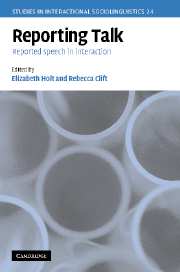Book contents
- Frontmatter
- Contents
- List of contributors
- Acknowledgements
- Transcription conventions
- 1 Introduction
- 2 Interactive Footing
- 3 ‘I'm eyeing your chop up mind’: reporting and enacting
- 4 Assessing and accounting
- 5 Getting there first: non-narrative reported speech in interaction
- 6 Reported thought in complaint stories
- 7 Designing contexts for reporting tactical talk
- 8 Active voicing in court
- 9 Speaking on behalf of the public in broadcast news interviews
- 10 The dead in the service of the living
- References
- Index
3 - ‘I'm eyeing your chop up mind’: reporting and enacting
Published online by Cambridge University Press: 22 September 2009
- Frontmatter
- Contents
- List of contributors
- Acknowledgements
- Transcription conventions
- 1 Introduction
- 2 Interactive Footing
- 3 ‘I'm eyeing your chop up mind’: reporting and enacting
- 4 Assessing and accounting
- 5 Getting there first: non-narrative reported speech in interaction
- 6 Reported thought in complaint stories
- 7 Designing contexts for reporting tactical talk
- 8 Active voicing in court
- 9 Speaking on behalf of the public in broadcast news interviews
- 10 The dead in the service of the living
- References
- Index
Summary
Introduction
In interaction reported speech can be used to portray what a current speaker, or someone else, said on a former occasion. However, it is by no means restricted to the accurate portrayal of prior locutions. In fact there is growing evidence to suggest that it rarely is this (Lehrer, 1989; Tannen, 1989; Clark and Gerrig, 1990; Wooffitt, 1992; Holt, 1996, 2000). Exploring reported speech in naturally occurring interaction reveals that it can, on occasion, be used to portray the words of invented (often stereotypical) characters and to suggest what someone might say/have said on some (often hypothetical) occasion. This chapter explores sequences involving this kind of reported speech. The analysis raises questions relating to the efficacy of approaches to the investigation of these hypothetical ‘enactments’, considering Goffman's observations on participation structure in comparison to a sequential approach.
Goffman's (1981) work on participation structure has important implications for the analysis of reported speech. His interest in the nature of participation in social encounters led him to criticise the simplistic concepts of ‘speaker’ and ‘hearer’ widely used in approaches to the study of language and communication. He sought to explore the complexity of the nature of participation by breaking down the roles into their constitutive concepts.
- Type
- Chapter
- Information
- Reporting TalkReported Speech in Interaction, pp. 47 - 80Publisher: Cambridge University PressPrint publication year: 2006
- 14
- Cited by



